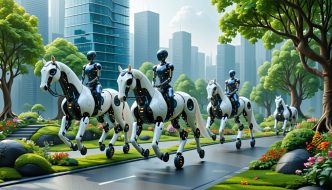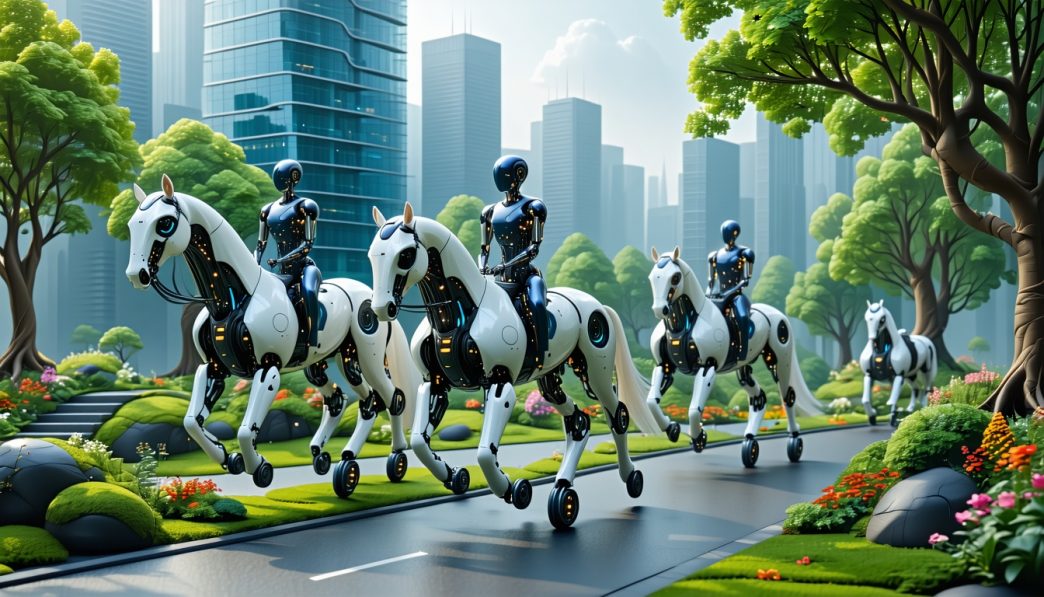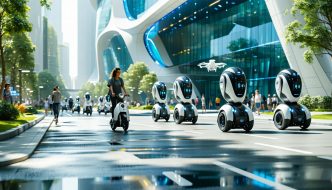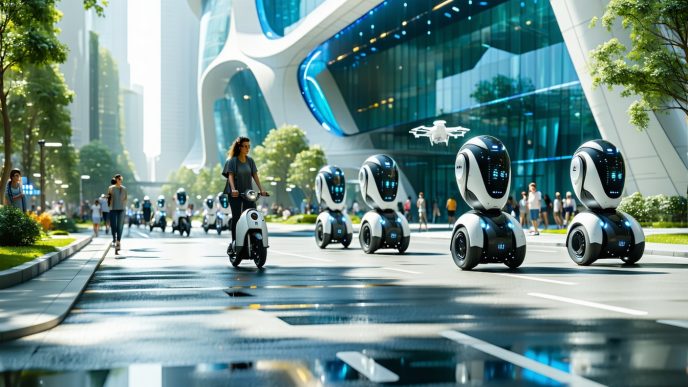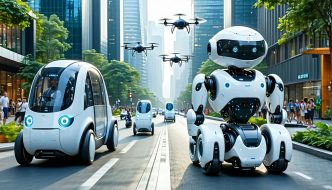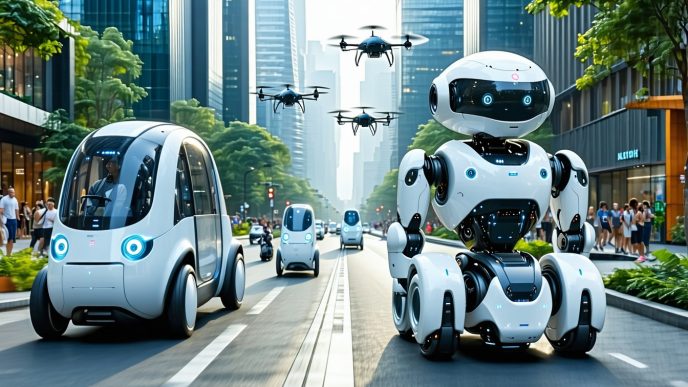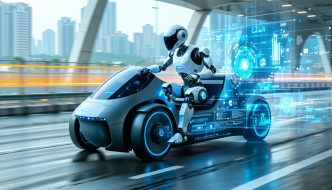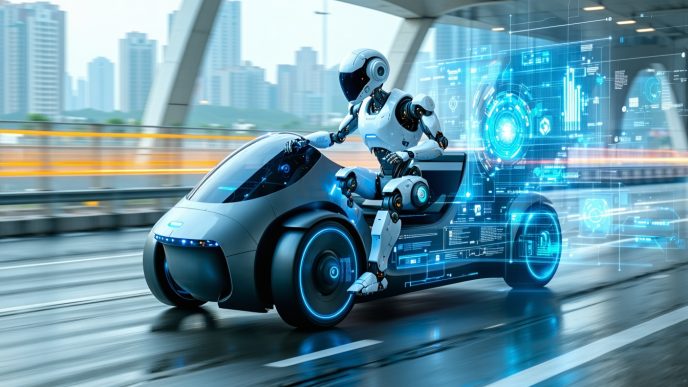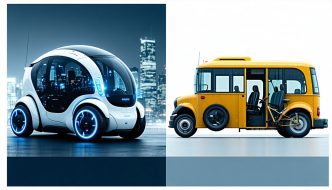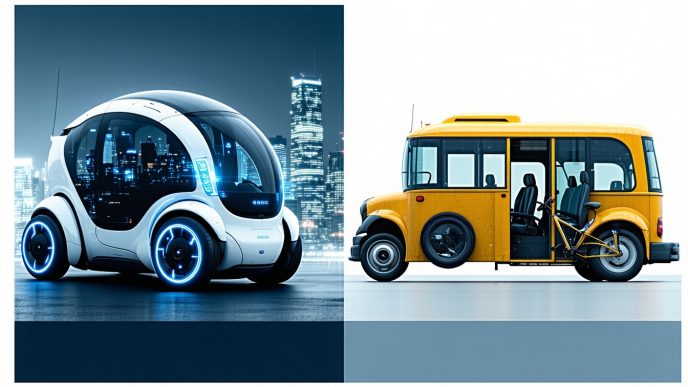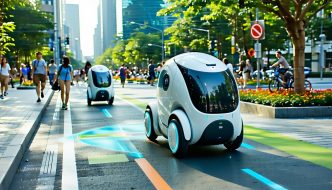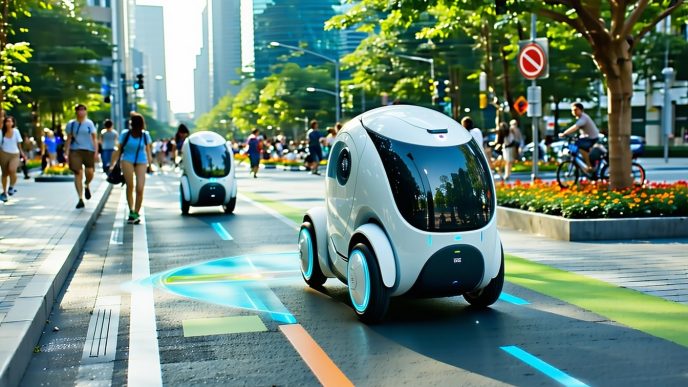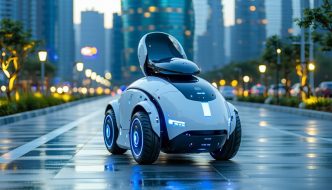Evolution of Transportation
The landscape of transportation has undergone significant transformation over the decades, evolving from conventional vehicles to groundbreaking innovations. This transformation has led to the emergence of advanced mobility solutions such as robot horses and animal-inspired transport.
From Traditional Vehicles to Futuristic Innovations
Traditional vehicles have long been the backbone of personal and public transportation. Cars, buses, and bicycles have served commuters reliably, but the introduction of technology has paved the way for futuristic innovations. These innovations include electric vehicles, self-driving cars, and now, rideable robots. Traditional methods are being complemented and, in some cases, replaced by high-tech alternatives that promise increased efficiency and sustainability.
| Vehicle Type | Year Introduced | Key Features |
|---|---|---|
| Horse-drawn Carriage | Ancient Times | Dependent on animal power |
| Automobiles | 1886 | Combustion engines |
| Electric Vehicles | Early 1900s | Battery operated |
| Rideable Robots | 2020s | AI navigation & agility |
As technology continues to advance, urban commuters are seeking more personalized and efficient transportation options. This shift has led to exploration within the realm of personal robot vehicles, including those inspired by animals.
The Rise of Rideable Robots
Rideable robots are increasingly gaining traction in urban areas. These robotic entities are designed to mimic the movements and characteristics of animals, notably horses. They are engineered for increased mobility, agility, and user comfort. The success of these devices lies in their intuitive design, which aims to provide a familiar riding experience while incorporating state-of-the-art technology.
The innovative designs of these robots facilitate various applications, from personal commuting to entertainment. With their unique blend of functionality and inspiration from nature, robot horses and similar devices represent an exciting frontier in urban mobility.
| Robot Type | Design Inspiration | Average Speed (mph) | Target Use Case |
|---|---|---|---|
| Robot Horse | Horse | 10 | Personal transport |
| Robot Dog | Dog | 8 | Companionship & mobility |
| Robot Mule | Mule | 12 | Cargo transport |
As cities grow more congested, the demand for innovative transportation solutions becomes more evident. The development of rideable robots, particularly those that take cues from animal movement, not only addresses this demand but also enhances personal mobility in exciting new ways. For more on the various aspects of transportation and vehicle evolution, refer to our article on robot transportation vs traditional options.
Animal-Inspired Robot Vehicles
Animal-inspired robot vehicles are leading the way in the evolution of personal mobility. These innovative designs draw from the characteristics of animals to create unique transportation solutions.
Features and Design Elements
The design of robot horses and other animal-inspired transports typically includes several key features aimed at enhancing performance, comfort, and user experience. Some common design elements include:
| Feature | Description |
|---|---|
| Biomechanical Movement | Mimics the natural motion of animals, providing a smoother riding experience. |
| Lightweight Materials | Construction from advanced materials for improved agility and speed. |
| User Interfaces | Intuitive controls and displays that enhance the interaction between human and machine. |
| Smart Sensors | Equipped with sensors for obstacle detection, navigation, and environmental awareness. |
| Customizable Design | Personalization options to cater to individual preferences and needs. |
These elements contribute to the functionality and effectiveness of robot horses and other rideable machines in various environments, particularly urban settings.
How Robot Horses and Animal-Inspired Transport are Revolutionizing Personal Mobility
Robot horses and animal-shaped personal transport devices are transforming the way people think about commuting and mobility. These innovations appear to offer various advantages:
-
Enhanced Mobility Options: Robot horses facilitate personal transportation without the congestion associated with traditional vehicles. They can navigate through narrow streets or pedestrian areas, which traditional transport methods may not access.
-
Eco-Friendly Solutions: Many of these devices incorporate sustainable energy sources, reducing their overall ecological footprint. The integration of battery technologies allows for efficient energy use, as seen in the table below:
| Type of Robot | Average Speed (mph) | Battery Range (miles) |
|---|---|---|
| Robot Horse | 15 | 30 |
| Animal-Inspired Pod | 10 | 25 |
-
User-Friendly Interfaces: The development of robot rider interfaces allows for seamless interaction between the user and the vehicle. This focus on design gets users accustomed to a new mobility standard while ensuring safety and comfort.
-
Versatile Applications: Beyond personal use, these robotic modes of transport can be adapted for various scenarios, from delivering goods in urban centers to serving as robot mobility aids for disabled users.
These animal-inspired designs embody a shift towards a more dynamic and responsive transportation landscape, creating opportunities for innovative mobility solutions. As these technologies advance, they are likely to play a pivotal role in shaping the future of personal transport, making it more efficient and enjoyable. For admiring more about these transformations, visit our discussions on transportation and rideability robots and the future of rideable robotics.
Benefits and Applications
The emergence of robot horses and animal-inspired transport is redefining the way individuals commute and interact with their environment. These innovative vehicles are not only transforming personal mobility but also presenting various benefits and applications that urban commuters and tech enthusiasts can appreciate.
Enhancing Commuting Experience
The integration of robot horses and similar devices into daily commutes offers numerous advantages. These vehicles provide an enjoyable experience by mimicking the natural movement of animals, making the ride more engaging and less monotonous than traditional transportation methods. With features designed for comfort and ease of use, they cater to various user preferences.
| Benefit | Description |
|---|---|
| Engaging Ride | Mimics animal movement, creating a more immersive experience. |
| Accessibility | Designed for ease of use, suitable for diverse users. |
| Reduced Congestion | Smaller footprint compared to cars, contributing to less crowded urban areas. |
Robot-assisted transport options also enable swift navigation through congested urban areas. They can adapt to traffic conditions more fluidly, allowing users to reach their destinations faster than with conventional vehicles. For those interested in short trips, rideable robots for short trips can be particularly advantageous.
Sustainability and Environmental Impact
One of the primary advantages of animal-inspired robots is their potential to promote sustainability. These vehicles can utilize clean energy sources, reducing carbon emissions compared to traditional fossil-fuel-powered transportation. As urban environments strive for greener alternatives, integrating robot horses into personal mobility can significantly contribute to environmental conservation.
| Environmental Factor | Impact |
|---|---|
| Carbon Footprint | Reduction in emissions through electric-powered solutions. |
| Energy Efficiency | More efficient use of energy compared to conventional vehicles. |
| Space Utilization | Smaller vehicles take up less space, reducing urban sprawl. |
Innovative designs can also incorporate renewable energy technologies, further amplifying their environmental benefits. For more details on how these vehicles compare to traditional options, explore our article on robot transportation vs traditional options.
Potential Challenges and Solutions
Despite the benefits, there are challenges associated with the adoption of robot horses and animal-inspired transport technologies. Concerns around safety, integration into existing transportation networks, and public acceptance remain prevalent.
| Challenge | Potential Solutions |
|---|---|
| Safety Concerns | Implementing robust safety protocols and incorporating features like rideable robot stability and safety. |
| Integration | Collaborating with established public transport systems to create seamless transitions. |
| User Acceptance | Educating the public on the benefits and safety of these innovative vehicles. |
Addressing these challenges through thoughtful design, education, and collaboration will be essential for the successful integration of these personal mobility solutions. Additionally, exploring advancements in robot rider interfaces can enhance user experience and foster acceptance among potential users.
Cutting-Edge Technology
The development of animal-shaped robots, specifically robot horses and other animal-inspired transport, is underpinned by innovative technological advancements. Two key aspects of this technology are autonomous navigation systems and the integration of artificial intelligence (AI) and machine learning, which significantly enhance personal mobility.
Autonomous Navigation Systems
Autonomous navigation systems are fundamental to the functionality of rideable robots. These systems allow robots to navigate complex environments without human input. Utilizing a combination of sensors, cameras, and mapping technologies, these robots can detect obstacles, understand their surroundings, and select the best routes for travel.
The following table outlines key features of autonomous navigation systems used in animal-inspired transport:
| Feature | Description |
|---|---|
| Sensors | Lidar, GPS, and ultrasound sensors help detect obstacles and interpret surroundings. |
| Real-Time Mapping | Robots continuously update maps of their environment, ensuring safe navigation. |
| Obstacle Avoidance | Algorithms allow the robot to identify and avoid potential hazards in its path. |
| Path Planning | The system calculates the most efficient route to the destination while considering traffic and obstacles. |
Autonomous navigation enhances safety and convenience, making these vehicles suitable for urban commuting and recreational use. For more details on the technological aspects of these robots, refer to our article on transportation and rideability robots.
Integration of AI and Machine Learning in Personal Robot Vehicles
The integration of AI and machine learning plays a crucial role in advancing the capabilities of robot horses and similar vehicles. By analyzing data from their sensors, these robots can learn from past experiences and improve their performance over time. This leads to enhanced user interactions and efficient operation.
Key applications of AI and machine learning in these types of transport include:
| Application | Function |
|---|---|
| Predictive Analytics | Robots can anticipate the rider’s needs based on patterns of use and environmental data. |
| Customization | Machine learning algorithms tailor the riding experience to individual preferences, such as speed and style. |
| Rider Interaction | AI-powered interfaces allow for intuitive communication between the rider and the robot, enabling personalized commands and feedback. |
| Safety Enhancements | Continuous learning helps improve the robot’s ability to respond to unpredictable situations, thereby increasing rider safety. |
The incorporation of these technologies not only enhances the riding experience but also contributes to the overall effectiveness of robot transportation solutions. For insights on strategies and trends in this field, explore our article on the future of rideable robotics.
As these technologies evolve, they hold the potential to transform personal mobility and integrate seamlessly with existing transportation networks.
Future Trends and Possibilities
As the landscape of personal mobility continues to evolve, the emergence of robot horses and animal-inspired transport presents exciting opportunities. Smart cities and connected transportation systems are poised to integrate these innovative vehicles, enhancing overall urban transit experiences.
Smart Cities and Connected Transportation
In the context of smart cities, robot horses and rideable robots are set to play a pivotal role in reshaping urban transportation. These robotic vehicles can communicate with each other and with the city’s infrastructure, allowing for efficient traffic management and reduced congestion.
Key Features of Smart City Integration
| Feature | Description |
|---|---|
| Real-Time Data Sharing | Vehicle-to-Infrastructure (V2I) communication enables robots to receive updates on traffic conditions and road status. |
| Adaptive Routing | Intelligent navigation systems can reroute based on real-time information, minimizing travel time and optimizing efficiency. |
| Sustainability Initiatives | Integration with renewable energy sources supports eco-friendly transportation solutions, addressing environmental concerns. |
This connectivity enhances commuting by promoting smoother journeys through intelligent traffic signal systems and predictive analytics, further emphasizing the benefits of transportation and rideability robots.
Collaboration with Public Transportation Networks
Collaboration between robotic transport solutions and existing public transportation networks has the potential to reshape commuting habits dramatically. By creating synergies with buses, subways, and other transit options, rideable robots can serve as a first-mile and last-mile solution, connecting riders to major transit hubs.
Benefits of Collaborative Systems
| Benefit | Description |
|---|---|
| Increased Accessibility | Robot horses can bridge gaps in public transport, making it easier for commuters to access transit options. |
| Cost-Effective Alternatives | This synergy can provide a more affordable solution for short trips, especially in densely populated areas. |
| Enhanced User Experience | Streamlined connections between robotic transport and public transit can create seamless user experiences, encouraging wider adoption. |
As cities embrace this collaborative approach, riders can experience a more integrated transport system that combines the convenience of rideable robots for short trips with the extensive networks of public transport.
The future of rideable robotics appears bright as it intersects with urban planning and development, promising improved mobility options for a diverse range of users. For insights on how these innovations impact user interaction, refer to our exploration of robot rider interfaces and the overall potential in the future of rideable robotics.

